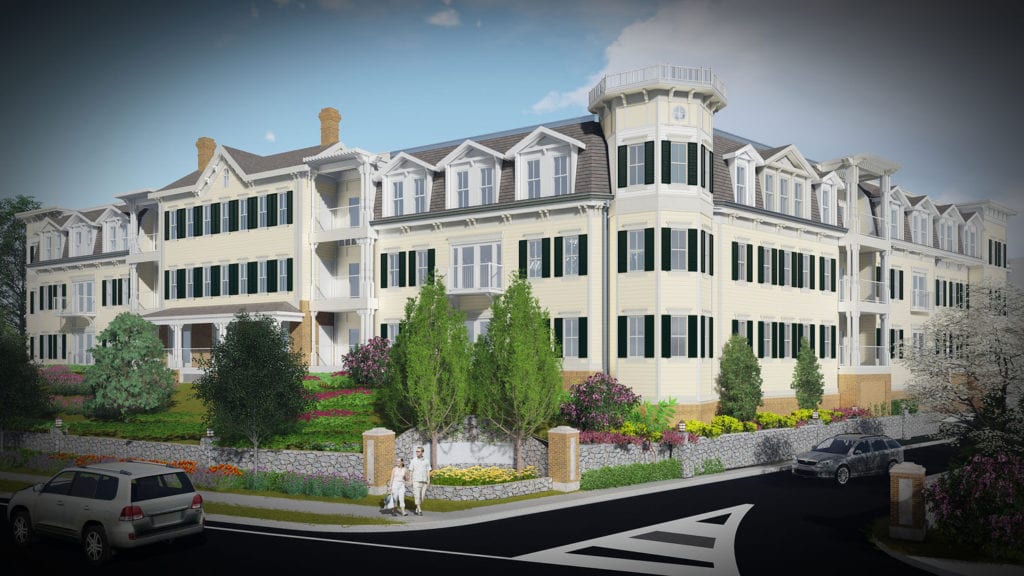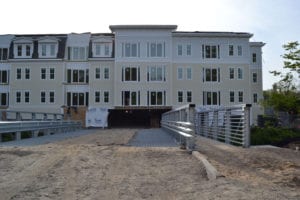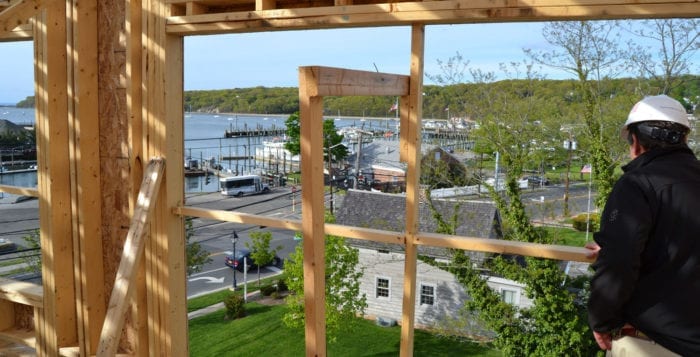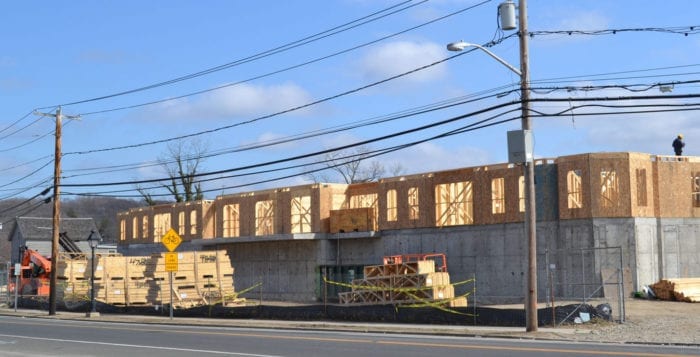By Alex Petroski
Entering Port Jefferson Village via West Broadway looks a lot different these days. The three-story structure being built on the south side of West Broadway, as drivers turn the corner and head down the hill into the village at what’s known as the community’s western entrance, is sprouting up rapidly and residents are taking notice.
Longtime members of the community have expressed concerns about the substantial size of the apartment complex, dubbed The Shipyard by TRITEC Development Group, the real estate developer responsible for the homes. Others have voiced worries about the impact new residents in the area will have on traffic, the possibility of disturbing the historic feel of the village and breaking with traditional architecture in Port Jeff, and the mindset of people who rent instead of own property —that they are less likely to be conscientious neighbors.

The 112-unit complex of one- and two-bedroom luxury apartments is being constructed on the former site of the Heritage Inn motel, and is expected to be completed by January 2018. TRITEC Vice President Robert Kent and director of marketing Chris Kelly opened the doors to the construction site during an interview May 12 to shed some light on what the community should expect from their new neighbors.
A common theme of letters to the editor submitted by community members was the building seems to exceed the 35-foot maximum established in the village’s code. One letter referred to the structure as “an unnatural behemoth in the middle of a small historic village.”
“Much of [Port Jefferson’s] architecture is historically authentic,” resident Karleen Erhardt wrote. “The natural beauty of its harbor and surrounding hills make it one of the loveliest spots on the North Shore of Long Island. It is no wonder that visitors come here year-round to escape the blur of boxy, vinyl-sided suburbia that now characterizes much of Long Island. The Shipyard has done irreparable damage to the character of Port Jefferson Village. All that we residents can do now is wait for the inevitable traffic congestion in and around our town that can only make life here worse.”
According to Kelly, the height adheres to village code because the currently exposed ground level will be covered with both dirt and eventually a sloped lawn up to the first floor level.
“The reason the code is written like that is because it’s Port Jeff — there’s hills,” Kent said. He added the process of getting plans for the project approved took about two years worth of back and forth with the village building and planning departments, as well as informational sessions for concerned community members. He also addressed claims the building won’t fit with the historic feel of the village. “We took dozens of photographs from homes in Belle Terre, to Danford’s [Hotel & Marina], we looked up historical buildings from the turn of the century, the old train station — we had our architects study all of that to pick a design that would fit in and complement what is here. We didn’t just come up with it.”
The ceiling of the leasing office lobby on the ground floor will be fitted with a grid modeled after century-old plans detailing construction of a 95-foot wooden deck barge, which Kelly said they found in the village’s historical archives.
“There’s a lot of things that take all of the history of this village and we’ve tried to incorporate it into what we’ve done,” Kelly said.

Kent said that transparency has been a key component of TRITEC’s plans throughout the process.
“When we say we’re going to do something we do it,” he said. “When we show you a picture of what we’re going to do that’s what you get. That’s what it looks like when we’re done. The way we do that is by thinking it out, being open and candid up front.”
In another attempt to address community concerns, the complex will only allow for those entering via the West Broadway entrance to make right turns in and right turns out of the property. A separate entrance exists on Barnum Avenue on the building’s southern side, which required the construction of a bridge to go over Mill Creek for entrance into the building’s parking garage.
Kent said TRITEC has spared no expense in the hopes of creating a luxury living option for those wishing to rent in the village. To do that, the company secured financial assistance from the Suffolk County Industrial Development Agency.
“To improve economic conditions in their respective areas, IDAs generally attempt to attract, retain and expand businesses within their jurisdictions through the provision of financial incentives to private entities,” an explanation of the role of the agencies from the New York State comptroller’s office said. “IDAs are legally empowered to buy, sell or lease property and to provide tax exempt financing for approved projects.”
As a result, Port Jefferson Village will lose out on property tax revenue, except in the form of payments in lieu of taxes, or PILOTs, that TRITEC will be required to pay for 15 years, as part of the agreement. To receive IDA financial assistance, the private company must also provide yearly proof of jobs created and retained as a result of the project.
Kent said the project will result in the creation of three to five permanent, full-time jobs within the building, in addition to the dozens of construction jobs already created, which Kent added could ramp up to more than 100 as the project progresses.
The vice president said the village should expect to see increased patronage of village businesses and restaurants, and a similar project in Patchogue resulted in millions of dollars worth of investment from other private entities looking to capitalize on a revitalized area. An economist hired by the village who studied the possible impact of the various construction projects in Port Jeff reiterated the same point during a presentation to the board in February.
“I think it’s a real disaster for the village that they were able to get this financial assistance. It’s like we’re giving away the store.”
— Molly Mason
Molly Mason, a village resident for 30 years, said in a phone interview she believes that the tax revenue the village will miss out on pales in comparison to the benefits suggested by TRITEC. She said she voiced concerns about the company pursuing IDA financial assistance during public hearings years ago.
“I think it’s a real disaster for the village that they were able to get this financial assistance,” she said. “It’s like we’re giving away the store.”
She also said she is worried about the impact on village infrastructure that the additional residences could mean, in addition to the possibility that renters with children would be sending kids to the district without contributing property tax dollars.
Some of the perks and amenities for those living in the new apartments will include various views of the water thanks to an abundance of windows throughout the units and a rooftop deck; dog washing and bike repair stations on the ground floor; full-sized washers and dryers in every unit; a fitness center with weights, machines and cardio equipment; charging stations for electric cars in the parking garage; a plaza area with barbecues, a fountain, fire pits and plenty of landscaping; and an indoor common area that features televisions, areas to do work, and couches, among many other perks.
Pricing details and leasing options will be available for those interested in the coming months.









